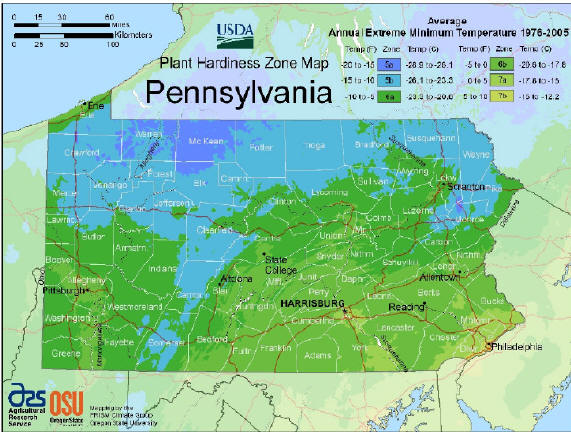There is a new measuring device now available to figure out what zone you live in based on what plants will grow where. In January 2012 (not so recent now) this new edition of the USDA Plant Hardiness Zone Map (PHZM) was published. It was developed to be internet friendly and enables viewers to examine plant hardiness zones at a much finer scale
than ever before. You will be able to type in your ZIP Code and your zone will be reported. It is possible to look at the entire United States or just your state. If you are now wondering how this is changing your plant choices and your planting schedule, check on your zone to see if it has changed. Zip codes for Hanover and Gettysburg show that we are in Zone 6b (-5 to 0
degrees F). The previous edition was in 1990 and it was questionable whether we were listed in 6a or 6b. Changing from 6a to 6b indicates a change in temperature of only 5 degrees warmer.

Another change has been made to divide the U.S. into 13 zones where previously there were 11. Zones 12 and 13 only appear on maps of Hawaii and Puerto Rico. The zones range from 1 (AK) to 13 (Puerto Rico). These zones on the new map are based on 1976-2005 weather data. Each zone represents the mean extreme minimum temperature for an area,
calculated from the lowest daily minimum temperature recorded for each of those years. It does not represent the coldest it has ever been or ever will be in an area, but simply the average of lowest winter temperatures for a given location for this time period.
Gardeners in our area tend to worry more about an extremely cold winter killing their plants rather than an extremely hot summer although a few extremely cold days in winter with a snow cover can be less of a problem than a one- to two-week heat wave.
This added information may help gardeners decide when to bring tropical plants indoors from a deck or patio as the temperature cools. Many of us can remember a time when the herb, Rosemary, wasn’t hardy in our area. Now you can find a variety ‘Arp’ that will live outdoors all winter. This map has a higher level of resolution and can show smaller
areas of zone delineations than ever before. Cities tend to hold more heat because of the large amounts of concrete and blacktop. Also in cities there are more people with enclosed yards or protected space that may accommodate more tropical types of plants longer into the winter season. This is called a ‘heat island.’
We also should keep in mind that Zone 6b in the East and 6b in the West can be completely different. If you are living in the Southwest where there is little rainfall and sometimes little snow, you will not have success with plants that grow in the East. Grass, or turf, is the best example of this—unless you waste water by irrigating or sprinkling
very frequently the grass we are familiar with simply doesn’t grow in the arid West. There are many perennials that are well adapted to arid conditions that won’t grow here in the East—the humidity will cause their roots to rot and die.
You may want to jump to the conclusion that these zone changes have been caused by global warming, but the USDA says that climate changes are usually based on trends in overall average temperatures recorded over 50 to 100 years (this map represents a 30-year average). It is true that we have had more numerous extreme weather events which may be
attributed to climate change, but actual global warming has many more factors than extreme weather events.
If all this information has left you wondering what to plant, you should always check the plant tag when you buy a plant. Plant tags serve many purposes. In addition to the pretty (and accurate) photo of the flower, you will find the zones in which perennials, shrubs, and trees are hardy. You will also find the Latin name, whether is should be in
sun or shade, and height and width of the plant. Best advice is to buy a plant sold in your area in a reputable garden store, plant following the directions, and keep the plant tag for future reference. When you buy annuals you know right away they won’t come back next summer—unless they reseed.
Perhaps you want to spend the winter researching some new plants for your garden. To find the USDA Plant Hardiness Zone Map for 2012, access http://planthardiness.ars.usda.gov.